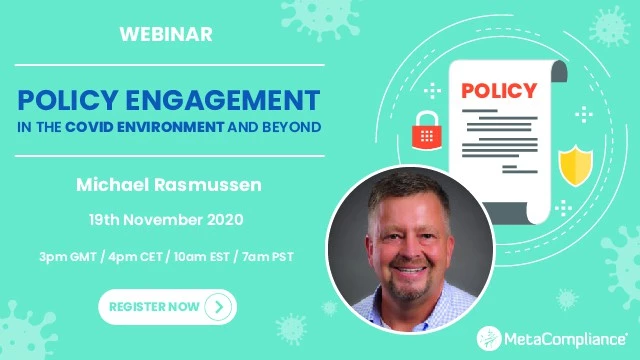The world has changed, business has changed. A worldwide pandemic has caused restructuring of processes, employees, and activities. It has forced organizations to look for agile ways to manage a dynamic business environment.
As organizations went into lockdown and moved employees to a work from home environment they were confronted with issues, such as:
- Reduced workforce. There were layoffs and restructuring. Business processes and roles had to adapt. Employees needed clear guidance and understanding of what is required of them as they had multiple roles and responsibilities in a different environment.
- Shifting requirements. Regulations and business strategy changed impacting the way organizations needed to conduct themselves. Policies changed to meet these requirements and address new risks.
- Increased risk exposure. The pandemic brought in increased risk exposures to fraud, security, bribery and corruption, and more. Remote video calls from home offices became less professional and language and interactions at times crossed the lines of harassment and discrimination. Employees needed reminders of what is expected of them in this time of change.
- New home office situations. With a massive move to a remote workforce policies and procedures had to change to address home office expenses, security, and more.
- Corporate culture. Employees were concerned about their health, future, finances, and the organization they worked for. They needed constant reinforcement of a strong corporate culture moving forward at a time they were physically disconnected from the office and their coworkers.
A Consistent Approach to Policy Engagement

It was clear that organizations needed a consistent approach to engage employees and let them know what is expected of them; that the organization is strong and in control in the midst of a pandemic. Unfortunately, most organizations were not prepared for this as their policy management portals were all over the place, inconsistent, and confusing.
For example, one firm, like many I talked to entering the pandemic, discovered they had over 20 policy portals in their organization. Policies were redundant across portals, inconsistent, contradicted each other, were in different templates and writing styles, and basically worked against the organization in a time of crisis. The portals themselves were not consistent. They also found a lot of rogue and unauthorized policies. Like many organizations, they did not know which policies the organizations actually had which hurt them in a time of change and crisis.
Effective management, communication, engagement, and enforcement of policies is critical in achieving consistent business objectives, managing uncertainty and risk, and acting with integrity. Policy management and communication is a cornerstone of a strong corporate culture. This is true in the course of normal business, but it is absolutely critical in a time of a crisis.
Facing a crisis, organizations discovered the need for a single portal into all the organizations policies and procedures where employees can easily find what they need when they need it as well as related resources. In a time of crisis, it is essential to show the organization is in control, has guidance for employees who have questions in change, and there is a greater need to develop and maintain a strong corporate culture and identity when employees are scattered and remote.
As organizations endure the current crisis, prepare for coming out of it, and look to the future the writing on the wall is clear. Policy management and employee engagement are critical in today’s dynamic, distributed, and disrupted business environment. Having an engaging, intuitive, and centralized policy portal that is agile to the needs, role, and context of the employee is critical to build a strong corporate culture and navigate the organization during normal business as well as in times of crisis.
To find out how you can streamline policy processes and engage employees in this time of crisis, join us for a webinar on ‘Policy Engagement in the COVID Environment and Beyond’
19th November 2020, 15:00 GMT | 10:00 EST | 07:00 PST
This 60-minute webinar will cover:
- How to maintain a central library of all the organisation’s policies.
- Writing policies that are consistent in style, template, and tone to improve culture.
- The importance of providing a single portal for employees to access policies and related training.
- Engaging employees in activities and interactions that support policy understanding.
- Measuring policy awareness, understanding, and conformance throughout the organisation.








